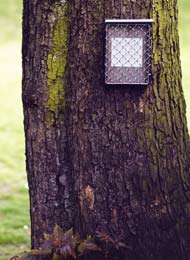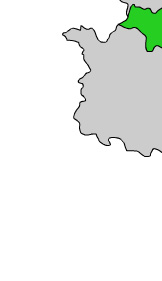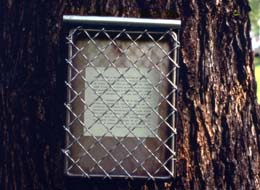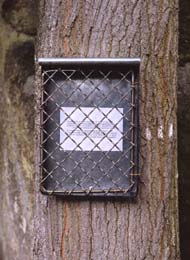 |
 |
 |

 Many butterflies, obsessed by the fleeting nature of life, try putting an end to it themselves. They thus head for roads where the traffic is intense, often highways, where they wait for the fatal automobile. But the air set in motion by the passing vehicles tosses their light bodies out of harm's way and prevents them from attaining their goal. Many butterflies, obsessed by the fleeting nature of life, try putting an end to it themselves. They thus head for roads where the traffic is intense, often highways, where they wait for the fatal automobile. But the air set in motion by the passing vehicles tosses their light bodies out of harm's way and prevents them from attaining their goal.
With the energy born of despair, they return inland, brighten the colours of their wings and seduce the first compact insect they happen upon; a bluebottle, ladybug or June beetle. Unable to resist fierce butterfly charms for long, these weightier insects blindly follow their seducers to the middle of the nearest road. There, the butterflies let themselves be embraced. Then they wrap their wings round their victims and drag them down in their fall.
|
 |
 |
 |
 |
 |

 From earliest nymphood and for the rest of their lives, Tilocules Appenda, the tiny insect of our prairies, carries a twig of hawthorn. Some slip it lengthwise into a back leg, others hoist it out in front of as if it were a flag. The choice of carrying-leg varies from one individual to another but in the majority of cases observed, the twig lengthens and conforms to the insect's every movement. From earliest nymphood and for the rest of their lives, Tilocules Appenda, the tiny insect of our prairies, carries a twig of hawthorn. Some slip it lengthwise into a back leg, others hoist it out in front of as if it were a flag. The choice of carrying-leg varies from one individual to another but in the majority of cases observed, the twig lengthens and conforms to the insect's every movement.
It was long thought that these twigs were meant for building nests or traps. But at no time of day or life do the Tilocules separate themselves from these altar egos -- except during one of the four or five stages of development when they trade an old twig for one that is longer, thicker or more knotted.
The truth seems to be that the Tilocules cannot accept their tiny stature and take to these artificial appendages in order to frighten potential predators. The appearance of hawthorn branches (the bark resembles the insect's wings) increases the likelihood of adversaries being fooled.
The Tilocules Appenda, whose organism was not designed to carry such a burden, dies in from exhaustion in the safety of illusion. Their hybrid cadavers are removed by red ants. The largest ants carry off the insect's actual body and the smallest carry off the twig.
|
 |
 |
 |

 The narton is a little forest rodent with the nasty habit of stealing into a nest of blackbird eggs during the female's brief absence. It then pierces the eggs with its sharp teeth and sucks out their contents. Drunk with pleasure, the little animal rolls in the plasma-covered shells which, when dry, stick to its dense fur, enveloping it almost entirely. The narton is a little forest rodent with the nasty habit of stealing into a nest of blackbird eggs during the female's brief absence. It then pierces the eggs with its sharp teeth and sucks out their contents. Drunk with pleasure, the little animal rolls in the plasma-covered shells which, when dry, stick to its dense fur, enveloping it almost entirely.
When it senses the mother bird's return, the narton jumps out of the nest and, encumbered by the shells, falls brutally to the ground without getting hurt thanks to its miraculous spotted armour.
The narton then finds itself incapable of resuming normal social life. It is constantly pursued by fellow nartons that are attracted to its newly acquired egg scent and colour. The narton's only way out of this predicament is to go back to the nest it has pillaged. There, the mother blackbird recognizes the traces of her own eggs, adopts the narton on the spot and begins madly fending off all assailants with her beak.
Thus pampered, the narton leads a peaceful existence that is only interrupted by the brief absences of its adoptive mother.
Then, one morning, the motherbird decides her baby has become an adult, picks off the tenacious egg shells still clinging to it and invites the fledgling to follow her flight. The narton does so without hesitating.
|
 |
 |

 Narties are small fresh-water fish that are frequently prey to pikes. In order to counter pike attacks, Narties store the air they swallow at the surface of the water and then deposit it in the form of bubbles along the many telescopic fronds of the limander, a familiar pond plant. The limander quickly covers the air pockets with a fatty excretion(juice(1). Narties are small fresh-water fish that are frequently prey to pikes. In order to counter pike attacks, Narties store the air they swallow at the surface of the water and then deposit it in the form of bubbles along the many telescopic fronds of the limander, a familiar pond plant. The limander quickly covers the air pockets with a fatty excretion(juice(1).
When a pike brushes one of these fronds, the sticky bubbles adhere to its scales and the air pressure pulls the pike irresistibly upwards. The thrashing of the trapped fish bursts the pockets of air which is at last free to rise to the surface where it propogates concentric circles.
Watching from the tops of neighboring trees, the Jicans Curcéoles, the Narties' indispensible accomplices, decipher the presence of the pike under the waving target that appears on the surface of the water. They fold back their wings and dive towards the victim which they crush in a single stroke of their large beaks.
Narties do not however feel any friendship for the Jicans who do not hesitate to swallow them down when they make a mistake in placing their bubbles.
|
 |
 |
 |
 |
 |
 |

 Over the past fifty years, the song of the meadow Tranestawp (1) has considerably atrophied. With each new generation, more and more of the bird's vocal heritage is lost. Of the "Tee-weel-lee-ee-ee Oo-woo-toh-oo-oh-oo-ee-toh-oo" that was its initial song and the "Tee-wee-ee-oh-oo-wee-ee-roh-oo" of the 1960s, all that is left is a raucous "Tee-oh-oo-tay". Over the past fifty years, the song of the meadow Tranestawp (1) has considerably atrophied. With each new generation, more and more of the bird's vocal heritage is lost. Of the "Tee-weel-lee-ee-ee Oo-woo-toh-oo-oh-oo-ee-toh-oo" that was its initial song and the "Tee-wee-ee-oh-oo-wee-ee-roh-oo" of the 1960s, all that is left is a raucous "Tee-oh-oo-tay".
Recent ornithological research has shown that the Tranestawp tends to leave the nest too early, before acquisition of the behavioral characteristics of its species is complete.The need for autonomy would thus appear to overide the bird's survival instinct. Nothing indicates however that the meadow Tranestawp population is dwindling (is an endangered species).
|
 |
 |
 |

 Because the shapes of the different letters of our alphabet are strangely similar to the many possibilities of Silmovin morphology, these tiny lizards that live in our countryside are irresistibly attracted to inscriptions engraved in stone. Because the shapes of the different letters of our alphabet are strangely similar to the many possibilities of Silmovin morphology, these tiny lizards that live in our countryside are irresistibly attracted to inscriptions engraved in stone.
Thus, whenever they cannot escape from the reader's steady gaze, Silmovins slink imperceptibly to the end of a word and, taking advantage of today's ignorance of spelling, hold perfectly still to go unseen.
|
 |
 |
 |
 |
 |
 |
 |
 |
 |
 |
 |
 |
 |
 |
 |
 |
 |
|